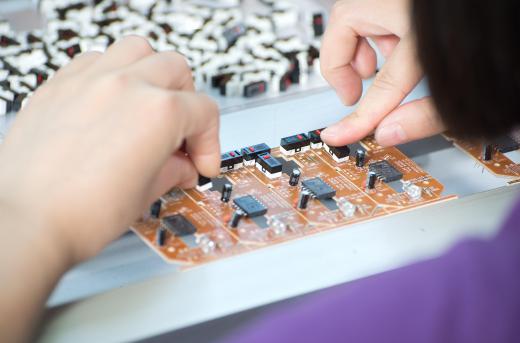Dip soldering is a manufacturing process where a technician dips objects into a bath of molten solder to fix parts together. The most common application of this technique is in the production of circuit boards, where it can be a fast and efficient method. The heat of the solder can potentially damage parts of the project, and the technician has to make sure all the components can take the heat before dipping; usually the project is all metal to avoid this problem.
With circuit board production, the solder will stick to the exposed mental components and will not adhere to areas without metal or areas treated with a chemical to resist solder. Dip soldering may be a hand operation, with a technician personally dipping the product, and it is also possible to partially automate it. A machine can grip the circuit board, dip it at the right angle, and keep it in the solder for the correct period of time before pulling it out.

The dip soldering process is similar to wave soldering, a mass production process people use to make chips. With wave soldering, it is all automated, and the chips pass under a steady flow of melted solder material, rather than being dipped. This process costs more money to implement and allows people to produce more projects per day, making it suitable for large scale facilities where people need to cut down on manufacturing time.
For small-scale soldering, dip soldering can be a useful technique. People do not need very much equipment to set it up, simply a container large enough to dip projects, with appropriate tools for melting the solder so it will be usable. Many companies manufacture the necessary supplies, and people can also make their own. For automated setups, slightly larger investments are needed to purchase a machine capable of handling the process.
People may learn this and other techniques on the job or while in a training program to prepare for a professional career. There are a number of types of solder available, and the technician has to be able to choose the correct mixture and make other decisions during the process to make sure the final product will perform properly. People usually inspect the project after dip soldering to see if any manual adjustments are necessary, such as cleaning excess solder off a contact or discarding an item with damage like pockmarks or distortions from the soldering process.
Ever since she began contributing to the site several years ago, Mary has embraced the exciting challenge of being a About Mechanics researcher and writer. Mary has a liberal arts degree from Goddard College and spends her free time reading, cooking, and exploring the great outdoors.

